The Android | What is Android | Androids | Android Market | App for Android | Android Apps | Android Application | Download Android | Tablet Android | Tablet PC | Phone Android | Android 2.2 | Android 2.3 | Android Free | Games for Android | Android Samsung | Galaxy Android | Android Google | Games Android | アンドロイド | Android | Android 2 | Android PC | Google Android | Android Galaxy | Phones with Android | Which Android Phone | What is an Android Tablet | What is an Android Phone
Distracted driving and cell phones
With the exception of Google Maps Navigation, which is designed for hands-free use with a car dock, Google Mobile products are not intended to be used while you are driving. Hand your phone to a passenger or park your car in a safe place if you need to search for a restaurant or check your email while behind the wheel.
For more information about distracted driving and how you can help prevent it, please visit www.distracteddriving.gov. And if you're in the US and have an iPhone, Palm Pre, or Android-powered device, you can go to Google.com in your browser today to see our mobile doodle. Do not do this while you are driving, of course.
The New Image Search for Android and iPhone
- The thumbnails are square to maximize the number of images we can get on the screen at one time so you can scan them quickly
- You can swipe to see the next or previous page of results, or tap the large, stationary 'Next' and 'Previous' page buttons
- We optimized for speed so that the images appear quickly when you browse
- The black background emphasizes the image and the buttons fade after a few seconds so you can just see images with little distraction
- Easily browse through the images by swiping from picture to picture
To try this new version of Image Search, just go to www.google.com on your phone and tap on “Images.” The new experience is available in 38 languages worldwide. Whether you like to look through pictures of prom dresses, impressionist paintings or 猫 ジャンプ we hope you love this update to Image Search for mobile.
Update on 6/2 @ 5:40 pm: This version of Image Search is now available for all Android and Palm webOS devices.
Posted by Leo Ting, Software Engineer, and Nick Fey, User Experience Designer
Multitasking the Android Way
[This post is by Dianne Hackborn, a Software Engineer who sits very near the exact center of everything Android. — Tim Bray]

Android is fairly unique in the ways it allows multiple applications to run at the same time. Developers coming from a different platform may find the way it operates surprising. Understanding its behavior is important for designing applications that will work well and integrate seamlessly with the rest of the Android platform. This article covers the reasons for Android's multitasking design, its impact on how applications work, and how you can best take advantage of Android's unique features.
Design considerations
Mobile devices have technical limitations and user experience requirements not present in desktop or web systems. Here are the four key constraints we were working under as we designed Android's multitasking:
We did not want to require that users close applications when "done" with them. Such a usage pattern does not work well in a mobile environment, where usage tends to involve repeated brief contact with a wide variety of applications throughout the day.
Mobile devices don't have the luxury of swap space, so have fairly hard limits on memory use. Robert Love has a very good article covering the topic.
Application switching on a mobile device is extremely critical; we target significantly less than 1 second to launch a new application. This is especially important when the user is switching between a few applications, such as switching to look at a new SMS message while watching a video, and then returning to that video. A noticeable wait in such situations will quickly make users hate you.
The available APIs must be sufficient for writing the built-in Google applications, as part of our "all applications are created equal" philosophy. This means background music playback, data syncing, GPS navigation, and application downloading must be implemented with the same APIs that are available to third party developers.
The first two requirements highlight an interesting conflict. We don't want users to worry about closing their apps, but rather make it appear that all of the applications are always running. At the same time, mobile devices have hard limits on memory use, so that a system will degrade or even start failing very quickly as it needs more RAM than is available; a desktop computer, with swap, in contrast will simply start slowing down as it needs to page RAM to its swap space. These competing constraints were a key motivation for Android's design.
When does an application "stop"?
A common misunderstanding about Android multitasking is the difference between a process and an application. In Android these are not tightly coupled entities: applications may seem present to the user without an actual process currently running the app; multiple applications may share processes, or one application may make use of multiple processes depending on its needs; the process(es) of an application may be kept around by Android even when that application is not actively doing something.
The fact that you can see an application's process "running" does not mean the application is running or doing anything. It may simply be there because Android needed it at some point, and has decided that it would be best to keep it around in case it needs it again. Likewise, you may leave an application for a little bit and return to it from where you left off, and during that time Android may have needed to get rid of the process for other things.
A key to how Android handles applications in this way is that processes don't shut down cleanly. When the user leaves an application, its process is kept around in the background, allowing it to continue working (for example downloading web pages) if needed, and come immediately to the foreground if the user returns to it. If a device never runs out of memory, then Android will keep all of these processes around, truly leaving all applications "running" all of the time.
Of course, there is a limited amount of memory, and to accommodate this Android must decide when to get rid of processes that are not needed. This leads to Android's process lifecycle, the rules it uses to decide how important each process is and thus the next one that should be dropped. These rules are based on both how important a process is for the user's current experience, as well as how long it has been since the process was last needed by the user.
Once Android determines that it needs to remove a process, it does this brutally, simply force-killing it. The kernel can then immediately reclaim all resources needed by the process, without relying on that application being well written and responsive to a polite request to exit. Allowing the kernel to immediately reclaim application resources makes it a lot easier to avoid serious out of memory situations.
If a user later returns to an application that's been killed, Android needs a way to re-launch it in the same state as it was last seen, to preserve the "all applications are running all of the time" experience. This is done by keeping track of the parts of the application the user is aware of (the Activities), and re-starting them with information about the last state they were seen in. This last state is generated each time the user leaves that part of the application, not when it is killed, so that the kernel can later freely kill it without depending on the application to respond correctly at that point.
In some ways, Android's process management can be seen as a form of swap space: application processes represent a certain amount of in-use memory; when memory is low, some processes can be killed (swapped out); when those processes are needed again, they can be re-started from their last saved state (swapped in).
Explicitly running in the background
So far, we have a way for applications to implicitly do work in the background, as long as the process doesn't get killed by Android as part of its regular memory management. This is fine for things like loading web pages in the background, but what about features with harder requirements? Background music playback, data synchronization, location tracking, alarm clocks, etc.
For these tasks, the application needs a way to tell Android "I would explicitly like to run at this point." There are two main facilities available to applications for this, represented by two kinds of components they can publish in their manifest: broadcast receivers and services.
Broadcast Receivers
A BroadcastReceiver allows an application to run, for a brief amount of time, in the background as a result of something else happening. It can be used in many ways to build higher-level facilities: for example the AlarmManager allows an application to have a broadcast sent at a certain time in the future, and the LocationManager can send a broadcast when it detects interesting changes in location. Because information about the receiver is part of an application's manifest, Android can find and launch the application even if it isn't running; of course if it already has its process available in the background, the broadcast can very efficiently be directly dispatched to it.
When handling a broadcast, the application is given a fixed set of time (currently 10 seconds) in which to do its work. If it doesn't complete in that time, the application is considered to be misbehaving, and its process immediately tossed into the background state to be killed for memory if needed.
Broadcast receivers are great for doing small pieces of work in response to an external stimulus, such as posting a notification to the user after being sent a new GPS location report. They are very lightweight, since the application's process only needs to be around while actively receiving the broadcast. Because they are active for a deterministic amount of time, fairly strong guarantees can be made about not killing their process while running. However they are not appropriate for anything of indeterminate length, such as networking.
Services
A Service allows an application to implement longer-running background operations. There are actually a lot of other functions that services provide, but for the discussion here their fundamental purpose is for an application to say "hey I would like to continue running even while in the background, until I say I am done." An application controls when its service runs by explicitly starting and stopping the service.
While services do provide a rich client-server model, its use is optional. Upon starting an application's services, Android simply instantiates the component in the application's process to provide its context. How it is used after that is up to the application: it can put all of the needed code inside of the service itself without interacting with other parts of the application, make calls on other singleton objects shared with other parts of the app, directly retrieve the Service instance from elsewhere if needed, or run it in another process and do a full-blown RPC protocol if that is desired.
Process management for services is different than broadcast receivers, because an unbounded number of services can ask to be running for an unknown amount of time. There may not be enough RAM to have all of the requesting services run, so as a result no strong guarantees are made about being able to keep them running.
If there is too little RAM, processes hosting services will be immediately killed like background processes are. However, if appropriate, Android will remember that these services wish to remain running, and restart their process at a later time when more RAM is available. For example, if the user goes to a web page that requires large amounts of RAM, Android may kill background service processes like sync until the browser's memory needs go down.
Services can further negotiate this behavior by requesting they be considered "foreground." This places the service in a "please don't kill" state, but requires that it include a notification to the user about it actively running. This is useful for services such as background music playback or car navigation, which the user is actively aware of; when you're playing music and using the browser, you can always see the music-playing glyph in the status bar. Android won't try to kill these services, but as a trade-off, ensures the user knows about them and is able to explicitly stop them when desired.
The value of generic components
Android's generic broadcast receiver and service components allow developers to create a wide variety of efficient background operations, including things that were never originally considered. In Android 1.0 they were used to implement nearly all of the background behavior that the built-in and proprietary Google apps provided:
Music playback runs in a service to allow it to continue operating after the user leaves the music application.
The alarm clock schedules a broadcast receiver with the alarm manager, to go off at the next set alarm time.
The calendar application likewise schedules an alarm to display or update its notification at the appropriate time for the next calendar event.
Background file download is implemented a service that runs when there are any downloads to process.
The e-mail application schedules an alarm to wake up a service at regular intervals that looks for and retrieves any new mail.
The Google applications maintain a service to receive push notifications from the network; it in turn sends broadcasts to individual apps when it is told that they need to do things like synchronize contacts.
As the platform has evolved, these same basic components have been used to implement many of the major new developer features:
Input methods are implemented by developers as a Service component that Android manages and works with to display as the current IME.
Application widgets are broadcast receivers that Android sends broadcasts to when it needs to interact with them. This allows app widgets to be quite lightweight, by not needing their application's process remain running.
Accessibility features are implemented as services that Android keeps running while in use and sends appropriate information to about user interactions.
Sync adapters introduced in Android 2.0 are services that are run in the background when a particular data sync needs to be performed.
Live wallpapers are a service started by Android when selected by the user.
More Blogginess
Hello everyone, and welcome to a rare (in this space) blog about blogging. My name is Tim Bray, and I’m the new editor of this Android Developers’ Blog. I am only a student of Android, but I’m a veteran blogger, I’m part of the Android team, and they’ve given me a pretty free hand to find and publish the interesting stories. I’m expecting to enjoy this and hope you will too.
The work on Android is done at various places around the world, but in Mountain View, California there’s a building on the Google campus with an Android statue in front of it, positioned among dessert-themed sculptures that illustrate the major platform releases to date.

As of now, this blog has a header image taken from where some of the Android work happens, behind the statuary looking out. There are a ton of places on the Internet where you can read people’s opinions about what’s happening next with Android, and a lot of them are good. The one you’re reading now is the one that’s written from the inside looking out.
History
This space has been used mostly in a just-the-facts press-release-flavored way and, while that’s been useful, I thought it could be livelier. Because, even after only a few weeks’ exposure to what’s going on here, I’ve discovered that there are a ton of interesting Android stories, and while some of them probably have to be secrets, there are more than enough we can tell to crank up the interest level here.
I offered this opinion internally, loudly and repeatedly, and Android management surprised me by coming back with “OK, it’s your problem now.”
Future
I’m not going to write everything here; I’m going to track down the people who actually do the creative Android-building work and get them to tell their own stories. I will bend over backward to make sure the articles have the voices of the people who write them.
We will go on being a source for hard opinion-free just-the-facts Android news. But I’d like to surround each burst of that with a cluster of reportage about what it means and how we think it will affect the Android communities.
The immediate future is going to be pretty intense, because we’re only a few weeks away from Google I/O, and I don’t think that I’m telling any secrets when I say that there will be Android-related announcements at that event. So the problems that come with the new job probably won’t include scaring up content.
The first new-flavor post is going to be on a currently-hot subject, multitasking and background processing, written by an engineer at the center of the Android universe.
Wish me luck, and stay tuned!
New Place Pages for mobile
To get more details on opening hours or on customer specific comments related to the food, service or ambiance, simply click on those respective sections to show more information instantly. The Place Page also provides links to useful websites where the user can read full reviews about the place. Lastly, if address and cross street information is not enough, click on the map button and you will be taken to a full screen dynamic map which is pannable and zoomable. In this way you can quickly see the restaurant's location in the context of the entire neighborhood.
To try this yourself, go to google.com on your phone's browser and search for "mama's sf". On the search results page, click on the listing for Mama's restaurant to go to the Place Page. This mobile optimized Place Page is currently supported on Android-powered devices and iPhones/iPod touches in the US.
Posted by Dan Zivkovic, Software Engineer, and Karen Groenink, User Experience Designer, Mobile Search
Search by Voice Comes to Google Maps 4.1 for Windows Mobile and Symbian S60 phones
Search by voice lets you easily search for anything by simply speaking your search terms instead of typing them. Just open Google Maps, press your phone’s “call” button, and clearly speak your search term like “Park Plaza.” Search by voice works with all the kinds of searches Google Maps for mobile already supports, including places, addresses (1600 Amphitheatre Parkway), specific businesses (The French Laundry), or types of businesses (sushi restaurants new york).
You may also notice a few other additions, including a redesigned settings page with Search by voice language choices. Choose your preferred language from the supported options, including multiple English accents and Mandarin Chinese. Also, if you find a problem with any information in Google Maps, you can use the “Report a problem” option to let us know.
To get started, install the latest version of Google Maps for mobile 4.1 for Windows Mobile and Symbian S60 by going to m.google.com/maps in your phone’s standard web browser (e.g. Internet Explorer on Windows Mobile). This update is available in all the countries and languages where Google Maps for mobile is currently available.
Visit our Help Center to learn more or tell us your feedback and questions in our Help Forum. Give us suggestions and vote on other people’s on the Mobile Product Ideas page.
Posted by Yuliang Wang and Yifei Zhang, Software Engineers, Google Mobile Team
Google Buzz Layer Now Available for Google Maps On Your Computer
With Google Buzz for mobile, you can choose to post publicly and include your location, providing context for your followers and allowing others to see what you have to say about a place on a map. We’ve received a lot of requests to make the Google Buzz layer available on desktop Google Maps, and today we're doing just that.
Now you can use Google Maps from the comfort of your computer to find out what people are saying about places near and far. If you’re new to the public Google Buzz layer, check out some tips for exploring the Buzz layer on Google Maps for mobile to see a few of the fun ways people have already been using it on their phones, sharing everything from breaking news to restaurant recommendations.
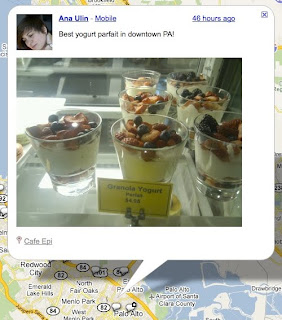
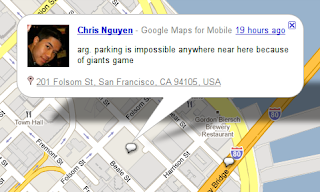
To view the Google Buzz layer from your computer, go to Google Maps in your web browser and select Buzz from the More... menu in the top right corner of the map. Find an interesting area like your neighborhood and select any available icon to see what’s going on there. In the post’s window, click on the name to see the author’s public profile, the timestamp to comment on the post, or the place to see it in Maps. The Google Buzz layer is available for maps.google.com in all currently supported languages.
The desktop layer is view-only, however, you can post using Google Buzz for mobile from the web app (buzz.google.com) on your phone, Google Maps for mobile, the Android widget, and more.
Posted by Ana Ulin and Evan Parker, Software Engineers, Google Mobile and Maps teams
Explore the UK and Ireland with Google Maps Navigation
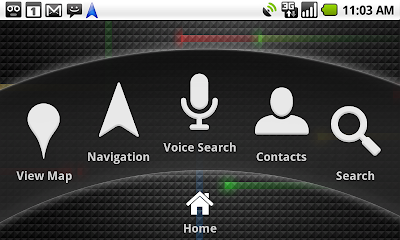
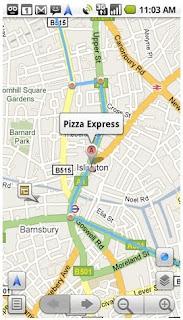
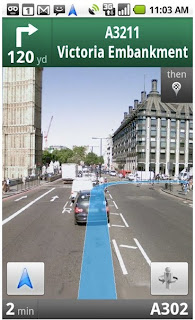
The Iterative Web App: Redesign of the Compose Page
You're on the subway and you get the brilliant idea to host a TV viewing party for your friends for the premier of Conan O'Brien's new show. You pull out your phone (or your iPad) and start typing names into the compose page at gmail.com. (Yes, it works on the subway.) You've added Naveed, Suzy and 7 others before you remember that Naveed made you eat grass at the last BBQ. You want to remove him from the list but his email address has scrolled way out of view. Argh! After some intense scrolling and lots of backspaces, you finally manage to get rid of Naveed's email address.
Enter our redesigned Compose page. It has new address fields that automatically expand to fit all the email addresses that you're entering, so you'll never have to worry about this type of problem again.
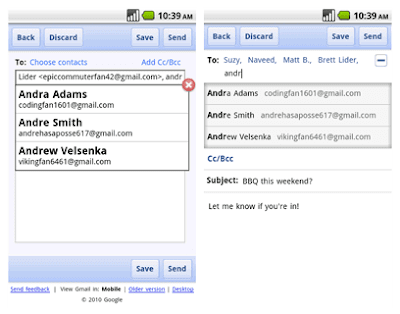
Once you select a contact from the autocomplete menu, you'll also notice that the contact becomes an object that you can tap on. Tapping on a contact opens a detailed view that let's you double-check the person's email address or remove them from the email. Yes, this means you can remove an email address in two taps!
Some other nifty new features which will help you compose your emails faster:
- Remove the contact you just added by tapping Backspace.
- Press the '+' button to see your top contacts, or hide them by pressing the '–' button.
- If for some reason autocomplete fails you and the person you are trying to reach is a Gmail user, just type their Gmail username and a comma, and we'll take care of the pesky @ sign and the rest (so [hikingfan] becomes [hikingfan@gmail.com].)
- The page now fills the entire screen, giving you more space to see what you're writing.
This update is available for Android, iPad, iPhone, and iPod Touch devices. We always love to hear what you'd like to see next, so be sure to leave your feedback in our Help Forum or the Mobile Product Ideas page!
Happy composing!
Posted by Andra Adams, Software Engineer Intern, Google Mobile
Google Mobile App for iPad now available in the App Store
While this first version of Google Mobile App for iPad is essentially the same app we’ve built for iPhone, we’re working on improving Google Mobile App so that it takes advantage of iPad’s features. Stay tuned as we continue to make it and other Google products even better on this new type of device.
To download Google Mobile App to your iPad, iPhone, or iPod touch (requires OS 3.0 or higher), search for “Google Mobile App” in the App Store or just visit http://itunes.com/app/googlemobileapp.
Posted by Alastair Tse, Software Engineer
Universal search features in Google Suggest for mobile
 Last December on the Official Google Blog, we announced how universal search features in Google Suggest could show useful information while the user is composing a query from the Google home page. Today, we are bringing this same functionality to mobile phones so that getting answers while on the go is even faster and easier. For example, let's say you're flying to London and want to know: Is my flight on time? Or what is the exchange rate of the pound? As you type the flight "Ba 284" or "Usd in pounds", the answers are provided right below the search box, without having to wait for the results page. Other searches that show answers include weather (e.g., "weather london"), stock quotes (e.g., "intc"), current time (e.g., "time london"), calculator (e.g. "29*37") and unit conversion (e.g., "220 miles in km").
Last December on the Official Google Blog, we announced how universal search features in Google Suggest could show useful information while the user is composing a query from the Google home page. Today, we are bringing this same functionality to mobile phones so that getting answers while on the go is even faster and easier. For example, let's say you're flying to London and want to know: Is my flight on time? Or what is the exchange rate of the pound? As you type the flight "Ba 284" or "Usd in pounds", the answers are provided right below the search box, without having to wait for the results page. Other searches that show answers include weather (e.g., "weather london"), stock quotes (e.g., "intc"), current time (e.g., "time london"), calculator (e.g. "29*37") and unit conversion (e.g., "220 miles in km"). To try this yourself, go to google.com on your phone's browser and type your own query to see these special results under the search box. Note that if you don't see these results at first, try refreshing the page in your browser. The functionality is currently supported on Android-powered devices, iPhones/iPods and Palm WebOS devices in the US.
To try this yourself, go to google.com on your phone's browser and type your own query to see these special results under the search box. Note that if you don't see these results at first, try refreshing the page in your browser. The functionality is currently supported on Android-powered devices, iPhones/iPods and Palm WebOS devices in the US.Posted by Toshi Tajima, Google Mobile Engineering Team
Google Maps 4.0 for BlackBerry adds Search by Voice, Google Buzz, Starring, Labs, and More
Search by voice
For starters, we’ve added Search by voice to all BlackBerry devices to save your overworked thumbs. Simply press and hold the green “call” button, speak your search, and see your results quickly appear without typing a single letter. Try it now for any search, like the name of my favorite hometown pizza place, “Punch Pizza in Minneapolis.” You can also search by voice for addresses like “802 Washington Avenue Southeast” or search for other another pizza place to try by speaking, “pizza restaurants.” Currently supported languages include multiple English accents and Mandarin Chinese.
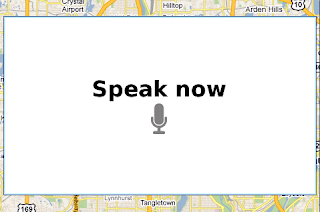
Google Buzz
Google Buzz for mobile also makes its debut on BlackBerry phones in Google Maps 4.0 (see availability). Use the Google Buzz layer to see what’s going on around you or to post to the layer yourself. Check out the many ways to explore the Buzz layer in Google Maps for mobile, including sharing pictures, news, and more. From the Maps main menu, select Layers > Buzz to enable the layer; open the menu and select “Post Buzz” to add your own public post from a location or place.
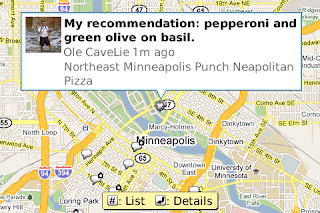
Take your searches and starred places to go.
Just like in Google Maps on Android, the BlackBerry version now provides personalized search suggestions from your maps.google.com search history. If I previously searched for “Punch Pizza” at home, I can simply type “pun” into Maps on my phone to see “Punch Pizza” at the top of the suggested search terms. Make sure you’ve signed in to your Google Account (Menu > Sign In) and have Web History enabled for your account.
Signing in to your Google Account also synchronizes starred items between maps.google.com on your computer (My Maps > Starred items) and phone (Menu > Starred Items). I’ll do my heavy pizza research at home, star several pizzerias I want to try, and browse the list in Google Maps on my phone when I’m ready to eat.
Wait, there’s more!
Also check out other new features added with 4.0:
- Use Labs to try experimental features like the Scale Bar or Terrain layer (great for hiking enthusiasts!).
- See nearby businesses at an address or location by selecting a point from the map.
- Report a problem with the map data or a business listing.
Visit our Help Center to learn more or tell us your feedback and questions in our Help Forum. Give us suggestions and vote on other people’s on the Mobile Product Ideas page!
Posted by Ole CaveLie, Software Engineer, Google Mobile Team
Gmail for mobile integrates with Google Buzz
.jpg) When Google Buzz for mobile launched in February, we created the mobile web app at buzz.google.com so you could post buzz on the go. Depending on your inbox integration settings buzz gets sent to your Gmail inbox when people @reply you, comment on something you’ve posted, or comment on a post after you.
When Google Buzz for mobile launched in February, we created the mobile web app at buzz.google.com so you could post buzz on the go. Depending on your inbox integration settings buzz gets sent to your Gmail inbox when people @reply you, comment on something you’ve posted, or comment on a post after you. With the latest iteration of Gmail for mobile, we’ve worked to integrate buzz with your mobile inbox. Now, you’ll see buzz in your inbox on your phone just like you do in the desktop version of Gmail, complete with the little Google Buzz icon. When you open a buzz post from your inbox, you can perform all the standard functions, such as liking the post or commenting, just as you can from the desktop Gmail inbox.
To try this out, simply go to gmail.com in your iPhone or Android browser.
Alex Kennberg, Software Engineer, Google Mobile
Google services on the iPad and tablet computers
While surfing the web on your iPad, we expect many of you will want to check your Gmail. If you go to gmail.com in your browser, you’ll see something different than what you’re used to on the desktop. We’re releasing an experimental user interface for the iPad built on the Gmail for mobile HTML5 web app that we launched last year for the iPhone and Android devices. Those devices have large screens compared to other phones, and tablets like the iPad give us even more room to innovate. To take advantage of the iPad’s large display, we’ve created a two-pane view with your list of conversations on the left and messages to the right.
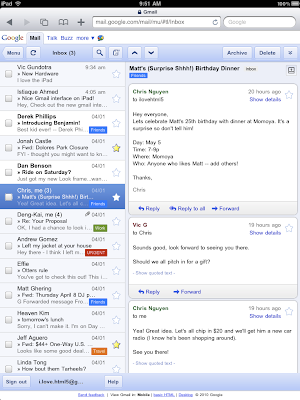
To try this new interface, go to gmail.com in your browser. We recommend adding a homescreen link for easy access. As this interface is experimental, expect changes as we continue to develop and optimize. Also, please let us know any ideas or feedback that you have. You can also access Gmail on the iPad through the native Mail app using the IMAP protocol.
Additionally, the iPad ships with a number of Google services pre-installed. As with Mac computers and the iPhone, you’ll find Google Search in the top right corner of Safari. The YouTube app for iPad is built-in, so you can watch HD videos and read and write comments. The new Maps app on iPad takes advantage of high-resolution satellite and Street View imagery, includes a new terrain view, and lets you search for local businesses and get directions. Just like on the iPhone, you can also go to the App Store to download Google Mobile App with search by voice. Of course, Google Mobile App was originally designed for the iPhone’s screen dimensions, but we’ve adapted it to work on the iPad and we’re looking into new ideas to make the app even better.
As you use Google’s web-based applications on iPad, you’ll notice that you sometimes see the desktop user interface and other times you see the mobile interface. We’ve evaluated the behavior of each Google web app using the iPad Simulator, and we are serving the interface we feel works best. If you’d like any help using our products on iPad, please click the 'Help' link within the product.
We’re particularly excited by how tablet computers create the opportunity for new kinds of user interaction. Here on the mobile team, we often talk about how mobile devices are sensor-rich: they can sense touch through their screens, see with a camera, hear through a microphone, and they know where they are with GPS. The same holds true for tablet computers, and we’re just starting to work through how our products can become even better on devices like the iPad.
Update on April 13, 2010 @ 11:40 AM: The new Google Mobile App for iPad is now available in the App Store.
Posted by Punit Soni, Product Manager, Google Mobile
Grunt, Woof and Moo to you too
This application allows you to record animal sounds and have the sounds analyzed and translated by Google Translate into any of the 52 supported languages. With animal translation you can finally understand why Spot keeps peeing in your closet or why Pickles keeps leaving dead mice in the tub. No longer must humanity struggle to comprehend when Lassie warns, “Hurry, Timmy’s fallen down the well!”
The technology isn’t perfect yet, so you may discover some translations that don’t make perfect sense. The algorithms are always improving however, thanks to the large corpus of cute cat videos that have been uploaded to YouTube.
We think that this is an exciting step in understanding and communicating with the world around us. Stay tuned for the addition of “old car” and “stomach” to the translation capabilities of the application this summer.
Posted by Woof Woofington, Product Barketing Manager via Google Translate for Animals
Our newest Mobile Search feature: Where am I?
Well, I’m happy to announce that for those of you who turn to Google in search of, “where am I,” we finally have a better result. Starting today, just go to Google.com on your phone in the US, search for “where am I”, and wonder about your own whereabouts no more.
Note that in this alpha release, we are finding that our results can be slightly off. However, accuracy should improve with greater usage. So if at first the answer is not what you’d expect, please continue to try it over the next couple of days and ask your friends to do the same.




